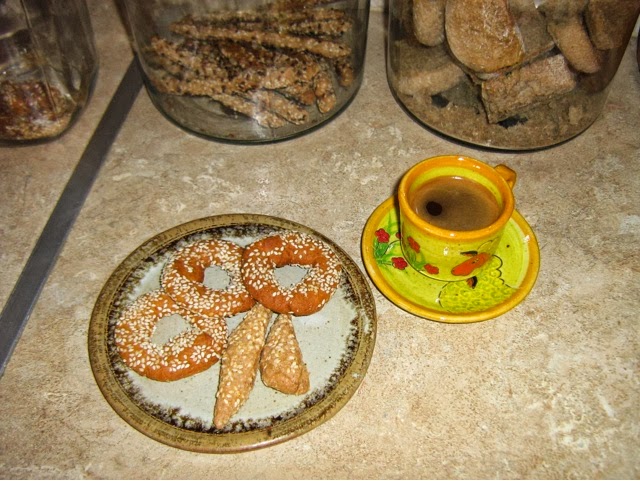Disclaimer: This is a way (not the only way) to make Greek coffee.
First, you will need the beans of your choice finely ground in a machine like the one in the first photo. All the makings are shown in the second photo, from left to right: sugar, the coffee, a briki, and a small cup. The briki is for cooking the coffee and can be aluminum with a heavy bottom, good for electric stoves, or brass, best for a gas flame.
Measure water into the briki using your cup. Mix in sugar, amount depending on taste, and the coffee. The amount of coffee also depends on taste, but Greek coffee is generally strong, so a heaping teaspoon, as shown in the photo, is the right amount per small cup. Stir until blended.
Put the briki on the element or flame at a low temperature. This coffee is best cooked slowly and best when it is not brought to a hard boil at the end. The next photo shows the coffee cooking, and the following one, the coffee just at the boiling point, when it should be removed from the heat. Stir the coffee a few times to develop the foam, and return to the heat, bringing it back to the boiling point. Remove again and stir again. The coffee should smell chocolaty and have a nice foamy "head".
Pour the coffee into your cup, see what snacks you can find, and enjoy.
Thursday, October 24, 2013
Wednesday, October 23, 2013
Catching up
We are behind with our blog posts, but we don't want to jump ahead just to catch up. So, the next two or few posts cover trips we took in September and early October, and we hope, even if they are a little late, you'll find them interesting.
After dropping Jeff off at the Iraklion airport, we continued east, but not far, camping near Sisi, just past the Minoan Palace of Malia. In the morning of the following day we visited the palace. In the afternoon, we visited the Lasithi Plateau, inland from Malia, famous for its windmills and the Dhiktean Cave, near Psihro, where Zeus was born. In fact, there are two caves on the island that boast being Zeus' birthplace: the Dhiktean Cave and the Idean Cave, not far away. Zeus knows which one, we will have to speculate.
These adventures left us with a late evening's drive to Ayios Nikolaos (Saint Nickolaus) on the east side of the Gulf of Mirabello. After driving down some uncomfortably narrow streets we finally found the hotel. Who were we to know that the entrance was by elevator from the back of a mini-mart?
The next day, from St Nick, we continued east, with Vai, the famous palm beach of Crete, as our destination, but stopping in Gournia, yet another Minoan town, on the way. Vai was crowded, but relaxing nonetheless, and we swam and toasted in the sun under the palms, before heading just a little further north to Itanos. Here are the ruins of an ancient Greek city, a small but lovely beach, and some flats away from the beach perfect for camping.
Sitia was our first stop the next day, where we spent who knows how much time in the museum looking at the excellent collection of pottery. From here, we headed out to our most eastern destination - could it be?, yes, once again, a Minoan palace, this time at Kato Zakros. We ended the day driving over the mountains to the south coast and camped near Koutsouras.
Heading home the following day, no Minoan palaces today, our main stop was the Arkadhi monastery, famous as a symbol of Cretan resistance; a sort of Cretan Alamo.
Here are a few pictures:
After dropping Jeff off at the Iraklion airport, we continued east, but not far, camping near Sisi, just past the Minoan Palace of Malia. In the morning of the following day we visited the palace. In the afternoon, we visited the Lasithi Plateau, inland from Malia, famous for its windmills and the Dhiktean Cave, near Psihro, where Zeus was born. In fact, there are two caves on the island that boast being Zeus' birthplace: the Dhiktean Cave and the Idean Cave, not far away. Zeus knows which one, we will have to speculate.
These adventures left us with a late evening's drive to Ayios Nikolaos (Saint Nickolaus) on the east side of the Gulf of Mirabello. After driving down some uncomfortably narrow streets we finally found the hotel. Who were we to know that the entrance was by elevator from the back of a mini-mart?
The next day, from St Nick, we continued east, with Vai, the famous palm beach of Crete, as our destination, but stopping in Gournia, yet another Minoan town, on the way. Vai was crowded, but relaxing nonetheless, and we swam and toasted in the sun under the palms, before heading just a little further north to Itanos. Here are the ruins of an ancient Greek city, a small but lovely beach, and some flats away from the beach perfect for camping.
Sitia was our first stop the next day, where we spent who knows how much time in the museum looking at the excellent collection of pottery. From here, we headed out to our most eastern destination - could it be?, yes, once again, a Minoan palace, this time at Kato Zakros. We ended the day driving over the mountains to the south coast and camped near Koutsouras.
Heading home the following day, no Minoan palaces today, our main stop was the Arkadhi monastery, famous as a symbol of Cretan resistance; a sort of Cretan Alamo.
Here are a few pictures:
Subscribe to:
Comments (Atom)





















